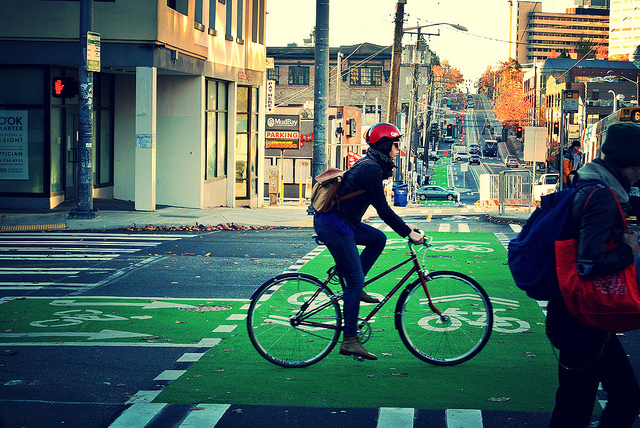DISCOVER YOUR LOCAL BICYCLING COMMUNITY
Find local advocacy groups, bike shops, instructors, clubs, classes and more!
BFC Spotlight: Seattle
Last month we announced our latest round of Bicycle Friendly Communities. There is now at least one BFC in all 50 states, and more than 69 million Americans live in a BFC. Seattle, WA, is a Gold-level Bicycle Friendly Community — this story comes to us from Dawn Schellenberg, community engagement liaison in traffic management for the city.
Seattle is honored to have our Gold Level Bicycle Friendly Community designation renewed. Residents and businesses continue to raise the bar and expect the delivery of first-rate, family friendly bike facilities. We are striving to meet this demand by building a citywide network that attracts people of all ages and abilities; all income levels; and all ethnicities. We are especially pleased that the League acknowledged the importance we place on equity.

Photo courtesy of the Seattle Department of Transportation
At the core of our efforts is the Race and Social Justice Initiative, launched in 2005 and expanded under Mayor Ed Murray. The Initiative works within City government and with community leaders to get to the root cause of racial inequity: institutional racism. Recognizing the important role government plays in adopting policies supportive of equity, Seattle’s Bicycle Master Plan calls it out as one of our five goals. We want to provide equal bicycling access for all; through public engagement, program delivery and capital investment. Working with the community, a number of steps were identified and included in the plan.
First, we looked at existing conditions. This includes mapping populations of color, households below 200 percent of poverty, households with zero cars available and populations below 18 and above 64. Then we added existing bike facilities. Through this analysis we were able to identify low bicycle service, or major gaps, in our system.
Second, we include equity in the evaluation criteria prioritizing projects identified in the plan. Points are assigned the evaluation criteria and then projects are ranked. The equity criteria helps ensure we are serving historically underserved populations and offering a health benefit to people in areas with the greatest reported needs.
Finally, we include equity as part of the Bike Master Plan evaluation. Our performance measures are outcome focused, instead of output based. This means we prioritize investments that do the best job achieving the desired plan outcomes instead of focusing on metrics that are more dependent on available resources that fluctuate year to year. Our performance measure target is to have zero areas of the city lack bicycle facilities by 2030. Our performance measure trend is to increase the percentage of females, older adults and people of color who ride regularly a few times a month or more.
Now that we have incorporated equity into our policies, to really be successful, we must involve the people we want to reach. With their participation and input, Seattle can continue building a world-class bicycle system that meets the needs of all our constituents.